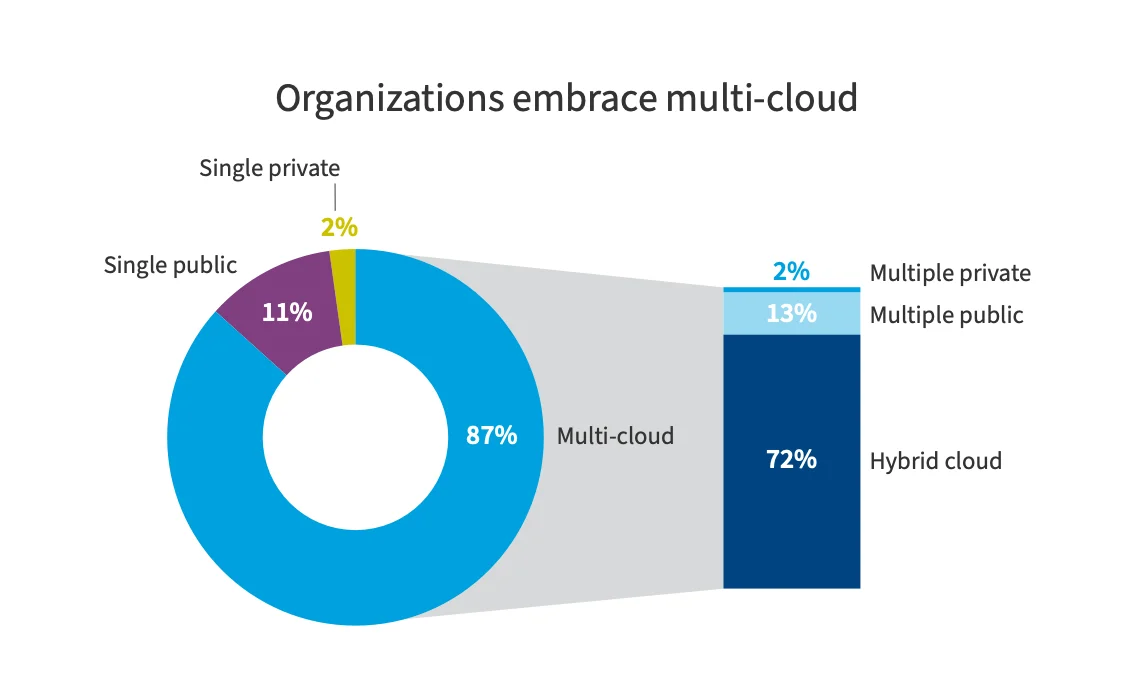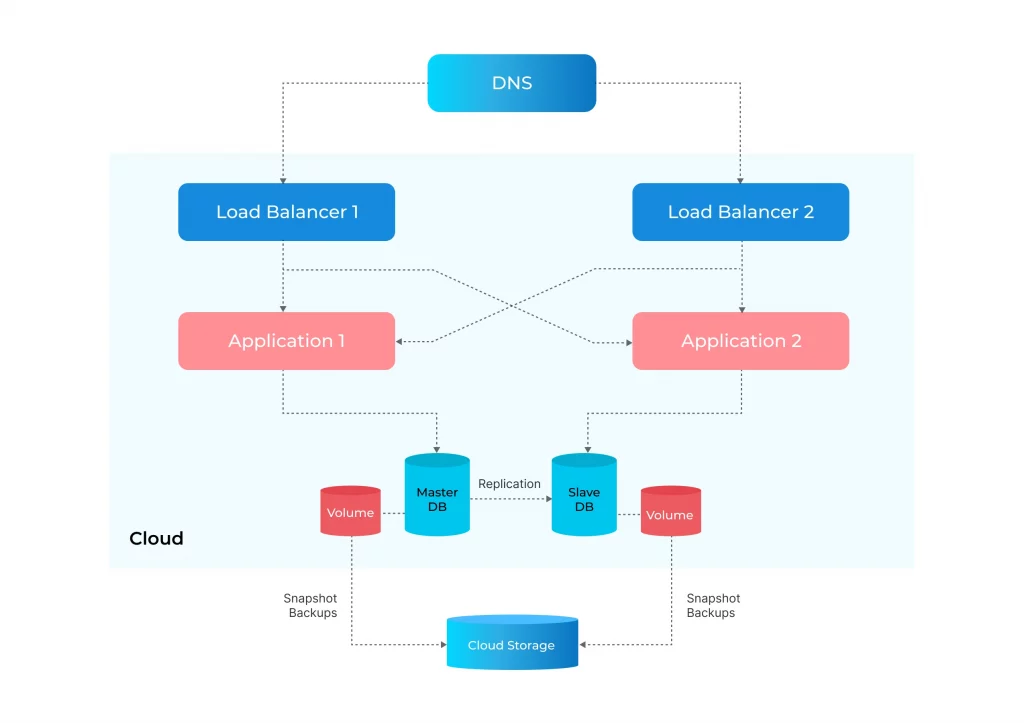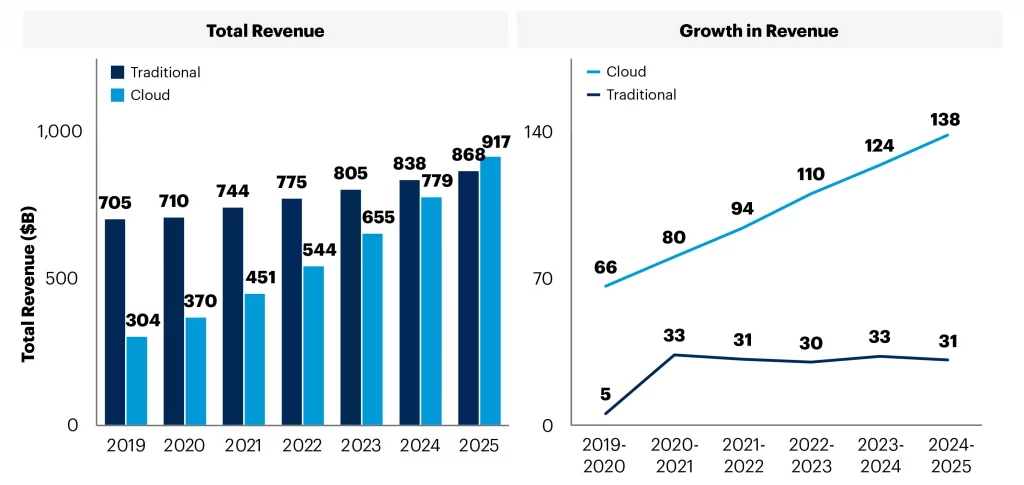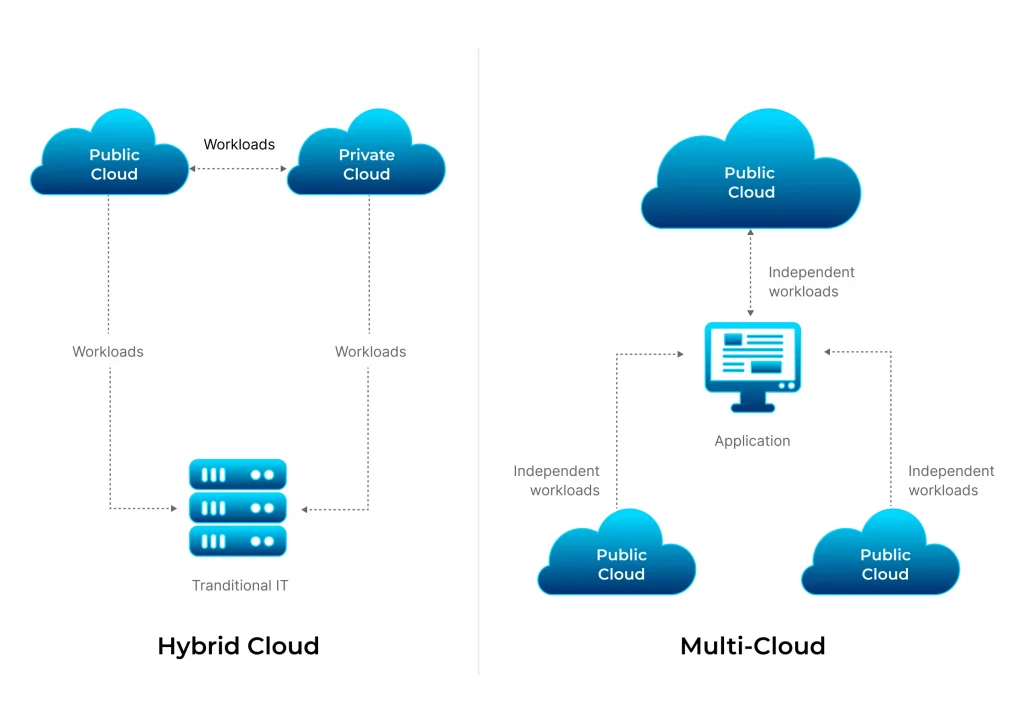Multi Cloud Architecture – Everything You Need to Know
- DevOps
- December 18, 2023
Multi cloud architecture approach is rising in popularity owing to its multifaceted IT infrastructure benefits for businesses, including scalability, strategic workload and data distribution, maximized efficiency, and more. In this comprehensive blog, we will not only provide you with a fundamental understanding of it, but also explore its benefits, drawbacks, implementation strategies, key considerations when operating in multi-cloud architecture, and more.
No wonder why we all have settled here to discuss multi cloud architecture!
With 87% of organizations, ranging from SMBs to large enterprises, reportedly using a multi-cloud strategy, it showcases the preference for this approach over hybrid or single cloud usage, according to Flexera’s 2023 State of the Cloud Report.

The reasons for its preference are many, starting with the set of benefits that attract tech giants to switch toward it and take advantage of the landscape the architecture offers.
So, today we are going to help you unlock the treasure that multi-cloud has got to offer businesses. We will let you know everything that you will necessarily need to know to take complete advantage of the multi-cloud architecture.
Let’s commence the journey of your association with multi cloud architecture:
What is Actually a Basic Cloud Architecture?
The primary cloud architecture is nothing but a set of 3-tier architecture around the web. Let’s talk in detail about the basic cloud architecture.
Talking about the 3-tier architecture, these three very tires are the Load balance server, Application server, and Database server. Every particular server is dedicated to each tier.

If you refer to the diagram, the redundant server has been used for every tier for failover and recovery purposes, if the data gets crashed by any chance then the redundant server will automatically move the saved copy of data into its prime place.
This is the minimalistic cloud architecture. But you can optimize it and make use of the additional server as per the requirements of your application.
Now that we have studied the basic cloud architecture strategies and designs, why don’t we reach the main subject of the discussion: multi cloud architecture? Let’s get the picture of a multi-cloud strategy first.
What is a Multi-cloud Strategy?
As the name suggests, a multi-cloud strategy is one that allows you to leverage the services of two or more public cloud service providers. You can actually use different cloud service providers for different purposes, that too all for a single application.
For example, you can opt for Microsoft Azure cloud for your US-based audience or you could use Google cloud for a different country. You may avail of Azure SQL for databases and Amazon EC2 instances and Load Balancing.
In a nutshell, YOU ARE PRIVILEGED TO GRAB THE ADVANTAGE OF MULTIPLE CLOUD SERVICES ALL FOR YOUR SINGLE APPLICATION.
The multi-cloud strategy also comprises on-premise private clouds like AWS EC2 and Azure Files. But the condition is that the cloud strategy should involve cloud services proposed by two or more public cloud providers, that strategy can be considered a multi-cloud strategy.
What makes multi-cloud architecture different from other cloud architecture is the attribute of helping businesses run different applications on a different cloud. You can develop and test environments on one cloud and do the rest of the process like a production environment on the other.
A multi-cloud strategy is a bag of benefits. But at the same time, it’s pretty important for businesses to abide by the vision, especially, when it comes to development costs.
Let us list out the 3 prime challenges that businesses do generally face when it comes to multi-cloud strategy:
- Businesses do face regulations and limits in certain countries for storing data, e.g., European unions.
- A group of users is not situated near the data center which causes trouble for businesses.
- Multi-cloud kind of misfits into the environment where public clouds are used with on-premises resources.
Why Do We Need a Multi-cloud Strategy?
By now, we are possibly much pleased with the advantages that a multi-cloud environment offers! Leveraging the best of technology for each and every category and adopting a pay-as-you-go model for the resources you consume, multi-cloud has already received its pay.
But here we want to address a few more casualties that are worth your read and more for adopting!
The growth and development of a multi-cloud environment
The growth of multi-cloud is taking place with impeccable speed and how. As per Gartner’s research, in 2022, more than $1.3 trillion in enterprise IT spending is at stake in shifting to the cloud, and the expected percentage is going to reach almost $1.8 trillion in 2025.
Afoot disruption to IT markets by the cloud will be strengthened by the introduction of new technologies, along with the distributed cloud. Soon the world will notice the blurred lines between traditional and cloud offerings.
By 2025, 51% of IT spending will be shifted from traditional solutions to the public cloud, compared to 41% in 2022. Almost 2/3 (65.9%) of spending on application software will be headed toward cloud technologies in the year 2025, up from 57.7% in 2022.

What Are The Benefits of Multi Cloud Architecture?
Let’s learn about the other crucial reasons to opt for a multi-cloud environment:
- The factor of risk management is crucial. Given the factor of risk management, multi cloud architecture always carries a plan B. In technical terms, if one cloud provider comes across a system outage, you can immediately move operations to another vendor until the service is fixed.
- If you have users from different countries or geographical locations then opting for multi-cloud service providers can boost your performance to a great extent.
- If your prime cloud provider does not have a presence in the locations that mandate data to remain in-country, thus utilizing a second cloud provider there will meet data sovereignty necessities.
- Multi-cloud environment architecture hosts applications closest to end-users.
- Multi-cloud environment architecture also avoids vendor lock-in.
What Are The Disadvantages of Multi Cloud Architecture?
Highlighting the side-effects that multi-cloud architecture causes to businesses:
- The chances of greater vulnerabilities get a bit higher as it’s multi-cloud. The more cloud providers are there in your multi-cloud strategy the more chances are there for it to be attacked by unauthorized parties.
- The factor of management and complexity is nerve-wracking as you need to get along with the complexities and nuances of each cloud platform.
- The factor of cost is something that could hinder your usage of a multi-cloud environment. Each cloud provider has different costs for each service and to estimate the overall budget considering every minor detail, you might need a good handle on the pricing structure of each cloud to get the math and draft calculations done.
6 Multi Cloud Architecture Designs You Should Know
Let’s discuss the 6 prominent designs that are the top choices of businesses for creating scalable and unwavering applications:
1. Cloudification
In this very multi cloud architecture design, the application that is hosted on-premises is able to leverage the cloud services of different cloud service providers or cloud platforms.
Let’s take a look at the example, this application can use AWS S3 and Azure Files for storing data. With the use of multi-cloud architecture, not only is this application capable of taking advantage of the scalability of the cloud, but it can also evade vendor lock-in and enhances availability and reliability.
Let’s take the example of Azure, suppose its services go down, the AWS service can still allow the application to function normally.
2. Multi-cloud relocation
In this architecture design, the application component is re-hosted on a cloud platform that was previously hosted on-premises. It’s also known as the lift and shift approach to cloud migration in which the application is configured to use a service from another cloud platform or a cloud service provider.
Let’s suppose that the application is relocated to AWS EC2, but still, it is fully capable of obtaining its data storage from Azure or the other cloud service provider the business is using.
3. Multi-cloud refactoring
In multi-cloud refactoring, the application is re-architected for the sake of providing better QoS so that it can be deployed to the multi-cloud environment. The application is re-architected like fine-grained components so that the deployment of high-usage components can be optimized on their own.
Then the applications are deployed on two different cloud platforms, say for example one on AWS and another on the Google Cloud platform.
In multi-cloud refactoring, the deployment of high-usage components is optimized for low-usage ones. The parallel design helps better throughput to multi-cloud platforms.
4. Multi-cloud rebinding
As with refactoring, a re-architected application is deployed partly on multiple cloud environments and facilitates the application to continue to perform with the use of secondary deployment whenever there are any chances of failure in the primary platform.
The biggest difference is that one or some more components are left on-premises, while the other component is relocated to split cloud platforms to fit as failover targets if, in case, the first deployment fails.
5. Multi-Cloud Rebinding with Cloud Brokerage
Multi-cloud rebinding with cloud brokerage is nothing but the participation of cloud brokerage in cloud rebinding that takes charge of integrating various components of multi-cloud infrastructure.
Also, multi-Cloud Rebinding with Cloud Brokerage assures that all components are functioning at their best along with optimal security.
6. Multi-Application Modernization
In multi-application modernization, rather than just re-architecting a single application for multi-cloud deployment, multi-application modernization calls for re-architecting various applications as a portfolio and then deploying them in a multi-cloud infrastructure.
The reason why you should opt for this approach is that individual applications, even if re-architected for the cloud, the cloud will have some flaws such as data inconsistencies, equivalent functionality, higher budget constraints, etc.
By scrutinizing every single application right before re-architecting them, you may find opportunities for consolidation and integration that would help them to function more linkage once deployed in a multi-cloud environment.
How to Implement Multi Cloud Architecture: Use Cases
The usage of multi cloud architecture is done for multiple reasons. Here we are going to discuss the most common use cases of multi-cloud architecture:
1. Disaster recovery
The biggest benefit you can have from the multi-cloud architecture is to obtain redundancy and plan for disaster recovery in a cloud-native deployment. Using multiple clouds allows IT departments to implement a modern 3-2-1 backup plan with three copies of their data that are stored on two different categories of media, with one stored off-site.
While the evolvement period of the 3-2-1 strategy, the other two are kept on-premises for the purpose of quicker recovery if there is a case of a data crash caused.
As businesses witnessed rapid improvement in the cloud, the requirement for an on-premises backup shifted. The data can now be obtained back as faster from a cloud as from on-premises infrastructure, and there are various companies that do not use physical infrastructure any longer.
For companies that want to switch towards or are already cloud-native, keeping data in more than one public cloud decreases the risk by keeping both production and backup data copies with one provider.
If there are any chances of disaster or ransomware attack, the multi-cloud user can restore data stored in their other cloud environment altogether, generally, one that offers tools like Object Lock to protect data with immutability.
2. Failover
There are many businesses that opt for multi-cloud environment services for the purpose of hosting mirrored copies of their active production data. If one of their public clouds goes through an outage, they have mechanisms in place to shift their applications to failover to a second public cloud.
Big tech giants like AWS do host more than 1 million websites on the behalf of their clientele. and an outage would take them all down. Having a single storage provider was a single point of failure that we grew less and less comfortable with over time.
Thus, multi-cloud came up with the use case of data stored in two public clouds. Amazon S3 and Backblaze B2 Cloud Storage. The content delivery network of AWS (CDN) pulls data from Backblaze B2 with Amazon S3 as a failover.
3. Data Sovereignty
There are many countries, along with the European Union, that have issued the law in order to regulate where and how the data can be fixed.
Companies subject to these data residency standards are capable of employing a multi-cloud approach to make sure their data meets regulatory necessities. They use multiple public cloud providers with different geographic footprints in locations where data has to be stored.
4. Accessibility to Specialized Services
Organizations can use different cloud providers to get their hands on specialized or complimentary services.
Say, for example, a company can make use of a public cloud like Google public cloud to get access to compute resources or bare metal servers, but store their data in a different, interoperable public cloud that is mainly designed for optimal storage.
Another example is a company that can make use of a cloud storage provider in combination with a cloud CDN to distribute content faster to its end users.
3 Key Things to Keep in Mind for Operating in a Multi Cloud Architecture
Now that we have learned everything about multi cloud architecture strategy from the top multi cloud architecture environment designs to its uses cases, last let’s learn about what are the key things to keep in mind while monitoring multi-cloud architecture:
1. Moving between environments
Moving applications or data between environments could be a high-budget task if it has been designed inaccurately.
Architecting your environment for the sake of making it move the applications between environments without the need to refactor. This is a matter of something to be kept in mind.
2. Design as per the operational requirements
Designing a simple architecture for a multi-cloud environment could be a time-consuming task, but if you go for a complex design, it can challenge your bandwidth at its core.
A suitable operating model that is influenced by the simplest path to achieving the objectives will enhance efficiency and make system management effortless.
3. Flexibility
At the time of designing your multi-cloud architecture, the crucial thing is to form an infrastructure that offers business agility. With the deployment of applications in clouds that best meet conditions, you can streamline your performance and design an effective cloud strategy.
What is The Difference Between Multi Cloud and Hybrid Cloud?
Here comes the most awaited segment of this article, many of us have numerous doubts when it comes to the difference between multi cloud and hybrid cloud, let’s get it clear:

Multi-cloud
In the simplest terms, “Multi-cloud” means multiple public clouds. A company that uses a multi-cloud deployment integrates multiple public clouds from more than one cloud provider.
Instead of a business employing a single vendor for cloud hosting, storage, and the full application stack, in a multi-cloud configuration, they operate more than one; several.
Hybrid Cloud
A hybrid cloud is one that allows applications to be operated in a combination of different environments. Hybrid cloud computing methodologies are widespread because almost no one in today’s date relies absolutely on the public cloud.
The difference between multi-cloud and hybrid cloud is one of the most raised questions when it comes to a multi cloud architecture. The key thing about a hybrid cloud is to remember that a hybrid cloud architecture always comprises one or more private clouds and one or more public clouds. In its simplest form, it can be a combination of one private cloud and one public cloud.
On the contrary, a multi-cloud architecture is designed in such a way that it must have two or more public clouds. It does not need to have a single private cloud.
Summing it up
If talking about the revamped scenario of technology and business development today, then cloud computing should be praised for its contribution to the same. One of those milestones of cloud computing: is multi cloud architecture, here we discussed it covering every possible detail, and it made us end up delving deeper into the concept.
Culminating this blog with incredible insights, hope each and every one of you had an insightful discussion with us. Moreover, having been influenced by cloud computing solutions, we never tend to lose the opportunity to learn more about this mind-boggling concept, with this spirit we have achieved many milestones and helped our clients achieve greater milestones than us!
Our dedicated team of Cloud engineers is always up to help you with bespoke cloud services.

FAQs on Multi Cloud Architecture
When you want to avoid vendor lock-in as it is a very typical reason for exploring a multi-cloud strategy, as most businesses are worried about becoming entirely dependent on a single provider and platform for their computing requirements.
Many businesses deploy hybrid models when they are required to scale up their IT infrastructure with great speed, such as when leveraging public clouds to supplement the capacity available within a private cloud.
Centralize Policy Configuration from Single Console, Integrate Data Security Capabilities as a SaaS, Integrate Security into DevOps, Deploy Zero Trust Data Protection, and, finally, Own the Master Key.













